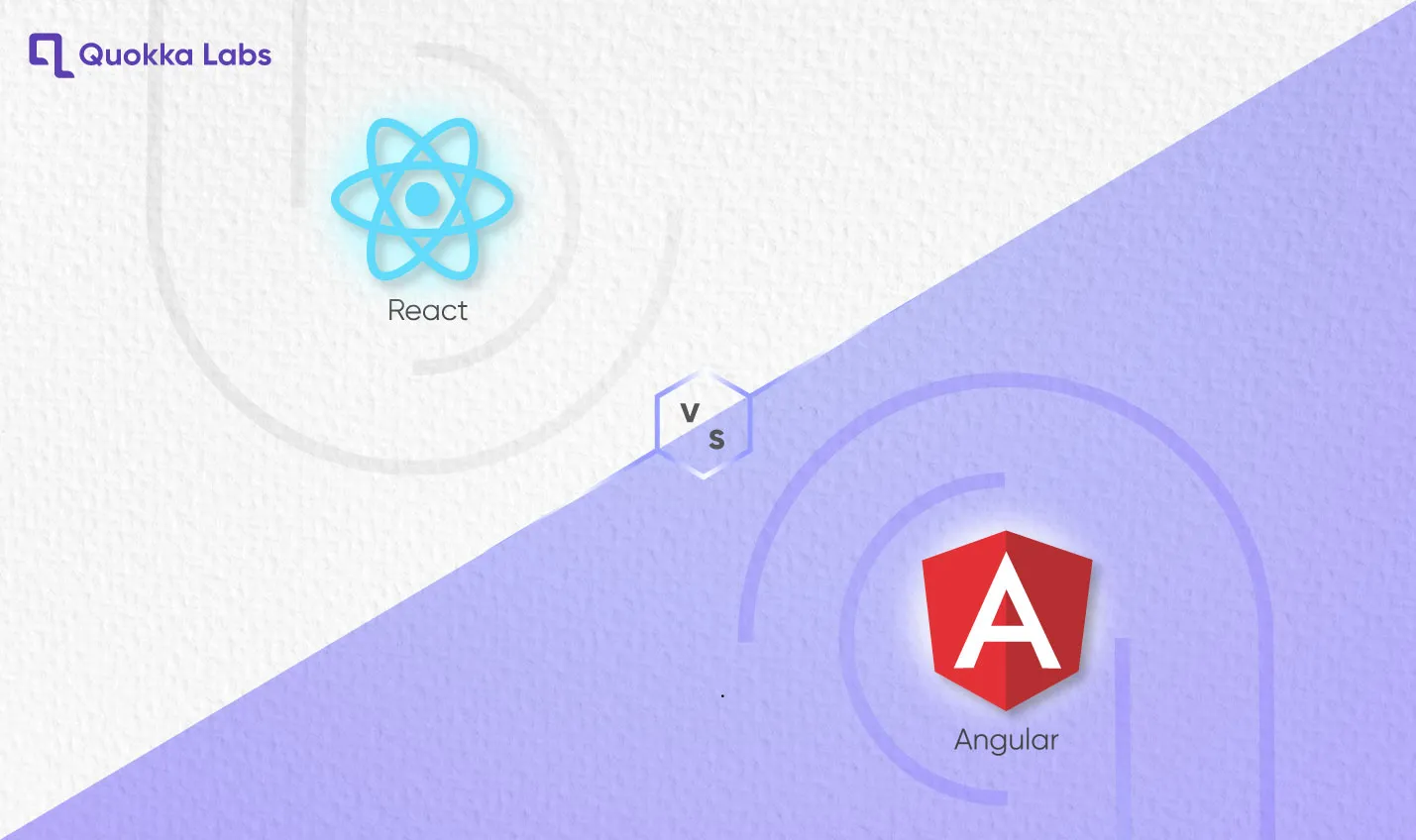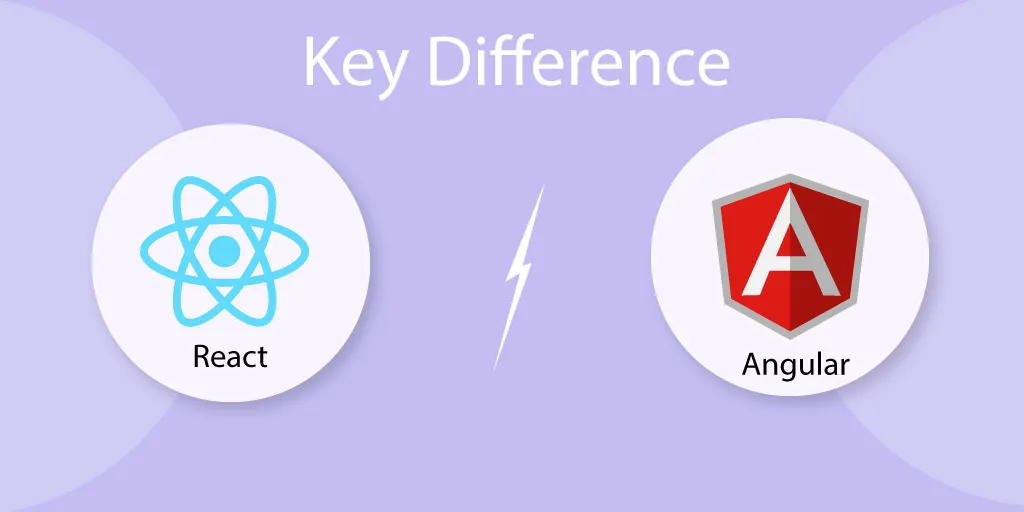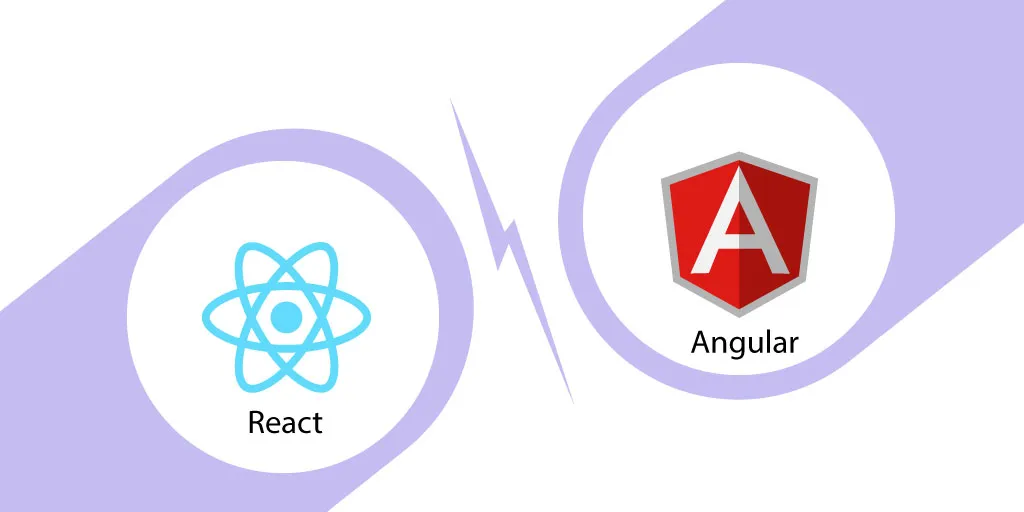Technology

5 min

The blog explores the ongoing debate between Angular vs React, two popular frameworks for front-end development. It provides a comprehensive comparison of their features, performance, scalability, and community support. The summary highlights the importance of choosing the right framework based on project requirements and team expertise.-

By Dhruv Joshi
03 May, 2023
The battle of the front-end frameworks rages on Angular vs React. Both offer powerful tools to build dynamic web applications, but which one is the best fit for your next project? In this guide, we'll break down the key differences between the React vs Angular, their strengths, weaknesses, and ideal use cases. By the end, you'll clearly understand which framework aligns with your development goals, skillset, and project requirements.
Meanwhile, if you are in a hurry, you can directly reach out to ours front-end development services.
Angular is a robust, open-source, TypeScript-based front-end web framework primarily maintained by Google. Initially released in 2016 as Angular 2 (a complete rewrite of the earlier AngularJS), it's evolved into a comprehensive platform for building dynamic, scalable web applications. While Google spearheads its development, Angular benefits from a vibrant community of contributors who actively enhance the framework.
Angular's flexibility allows for easy integration with various libraries, extending its capabilities to meet diverse project needs. It was designed to compete with React adopting a component-based architecture while retaining features like dependency injection (DI) and two-way data binding, which many Angular developers appreciate.
The most recent major version of Angular is currently Angular 18, released in May 2024. (Keep in mind that Angular releases new versions regularly, so it's always good to check the official website for the absolute latest). This version focuses on enhancing performance, developer experience, and tooling.
Full-Fledged Framework: Offers a robust, all-inclusive toolkit for building large-scale web applications, handling everything from routing and forms to dependency injection and beyond.
TypeScript: Uses TypeScript, a superset of JavaScript that adds static typing, improving code maintainability and catching errors early.
Component-Based Architecture: Encourages building applications with reusable components, promoting modularity and maintainability.
Two-Way Data Binding: Simplifies data synchronization between the UI and the underlying data model.
Dependency Injection: Facilitates loose coupling between components, making them easier to test and reuse.
CLI (Command-Line Interface): A powerful tool for quickly scaffolding new projects, generating components, and managing dependencies.
Strong Community and Ecosystem: Thriving within a vast community of developers, you'll find extensive support, resources, and a wealth of libraries and tools to accelerate your projects.
Suitable for Large-Scale Applications: The framework's structure and features make it well-suited for building complex enterprise-level projects.
Points to Consider
Learning Curve: Can be steeper than some other frameworks due to its extensive features and TypeScript.
Performance: While Angular performs well, some specific use cases might benefit from React's Virtual DOM approach.
Opinionated Structure: While helpful for consistency, it might not be the best fit for every project or team.
ReactJS is a widely used open-source JavaScript library designed for building user interfaces, first released by Facebook in 2013. Unlike traditional MVC frameworks, React focuses solely on the view layer, allowing developers to choose their own tools and patterns for state management. This flexibility makes React a popular choice for building both web and mobile applications.
React's component-based architecture promotes reusability and modularity, making it easier to build complex UIs. While not mandatory, React's JSX syntax (a JavaScript extension that looks like HTML) offers a convenient way to define component structures.
A key innovation of React is its Virtual DOM (Document Object Model), a lightweight representation of the actual DOM. This allows React to efficiently update the UI by calculating the minimal changes needed, leading to improved performance.
React 18, released in March 2022, brought significant improvements to the rendering engine and introduced a new concurrent rendering API. This foundation enables exciting new features like Suspense, which allows for better loading states and code-splitting, and Server Components, which can improve server-side rendering performance.
Library, not a framework: Provides flexibility and works well with other libraries.
Developed and maintained by Meta (formerly Facebook): A large company backing ensures continued development and support.
Easy learning curve: Relatively straightforward for developers familiar with JavaScript.
Virtual DOM: Enables efficient updates and improves performance.
Open source: Free to use and backed by a large community.
Unidirectional data flow: Promotes predictable behavior and easier debugging.
Server-side rendering (SSR): Improves SEO and initial page load times.
Component-based architecture: Makes code reusable, maintainable, and scalable.
Works with web and mobile: Can be used with React Native for mobile app development.
Flexible ecosystem: Numerous third-party libraries and tools available.

As a side task, Angular was built by two developers named Adam Abrons and Misko Hevery. They imagined the Get Angular task to work on web development and permit website specialists to connect with the back and front end. Misko Hevery was a developer at Google, while Adam Abrons, who was working with Hevery on a Google project, named Angular after HTML as HTML contains Angular sections.
Hevery was dealing with a Google project named Google feedback with two additional members in the group. In more than a half year, they've composed 17000 lines of code. Even with the expanded code size, it took a lot of work to alter and test the code the group had composed. In this way, Henry bet his supervisor that he could compose the whole task with his side venture in a few days. He lost the bet and required three weeks to compose the code, yet he could press the 17000 lines down to 1500. His administrator considered his accomplishment, and the development of Angular.js started to speed up.
React was built by Jordan Walke, a programmer at Facebook. He first delivered a model of React, which came to be known as "FaxJS." Afterward, he deployed it on Facebook's News feed in 2011 and Instagram in 2012. React at last turned into open-source software in May 2013. React Native mainly empowers Android development and iOS development, with React declared open-source in 2015. Afterward, resulting adaptations of React were announced as open-source in 2017. Thus, on September 26, 2017, React was first delivered to the public.
Performance is a serious factor in choosing a front-end framework. A slow, unresponsive application can frustrate users and negatively impact your website or product. Let's compare how AngularJS and React JS stack up in terms of performance:
React JS: Generally, has a faster initial load time due to its smaller bundle size and efficient virtual DOM rendering.
AngularJS: Can have a slightly slower initial load time, especially for larger applications, due to its comprehensive feature set and dependency injection system. However, Angular's ahead-of-time (AOT) compilation can mitigate this.
React JS: Excels in runtime performance, especially with frequent UI updates. The virtual DOM efficiently calculates the minimal changes needed, leading to faster rendering.
AngularJS: Offers comparable runtime performance, thanks to its change detection mechanism and optimizations like OnPush change detection strategy.
React JS: Provides more granular control over performance optimization through techniques like memoization, shouldComponentUpdate, and code splitting.
AngularJS: Offers optimization tools like OnPush change detection, lazy loading, and AOT compilation, which can significantly improve performance in large applications.
Both AngularJS and React JS can deliver high-performance applications when properly optimized. Real-world performance often depends on factors like application size, complexity, code quality, and the specific use cases.
Direct performance comparisons between AngularJS and React JS can be misleading, as benchmarks often depend on the specific test scenarios and implementation details. However, general trends suggest that React may have a slight edge in raw performance, especially for smaller applications with frequent UI updates.
Angular is useful when utilized in the following circumstances:
It is valuable while creating web app development for all conditions and architecture.
Angular is typically used to build dynamic web applications where the contents get displayed per users' needs and requirements.
It gives you a solid and versatile framework.
TypeScript sees this as more superficial to work with Angular.
Planning and building business-level web applications likewise require Angular. Since numerous libraries are involved, Angular is the best in such cases.
Developers who need to configure single-page, fundamental yet unique web applications use Angular.
React tool mainly focuses on time-saving. It is useful when utilizing the below circumstances:
In the single-page and cross-platform application advancement.
Assuming you're hoping to expand an application's existing capacities.
Considering making light applications that have modern abilities.
Your focus should guarantee high client connection if you deal with a front-end UI. In such a situation, it's proposed that you use ReactJS because it will deal with the lower-level algorithm and let you focus on the view model of the connection point.
Think about a project that needs a massive number with consistently evolving states; you could utilize ReactJS because a powerful tool will assist with dealing with the changing conditions of the parts.
When you can't command the existing code and it has developed muddled, you must use ReactJS.
In instances of reliable grumblings concerning the site's lack and unresponsive pages, you need to utilize React to guarantee the smooth running of the site.
ReactJS is additionally used to oversee the application once it grows and increases continuously.
Better functionality: You get all of the fancy odds and ends of an undeniable MVVM framework, including dependency injection, two-way, directing, structures, templating, data binding, and security.
Consistency: Angular developers love to do things "the Angular way." The framework is more obstinate than React, implying that application development approaches are steady across ventures and developers.
Dependency Injection: DI makes testing individual parts in separation more straightforward. Overseeing conditions with DI is a lot simpler and can save you time while building large applications. It makes React well-known for enormous enterprise applications.
Typescript: It is JavaScript with static sort checking to prevent blunders in your code and permit you to rehearse practical programming.
Angular-language service: Adds programming efficiency elements to your integrated development environment (IDE), including auto-culmination, error checking, and AOT diagnostic messages.
Productivity & Efficiency: Angular gives you all you want from the case to assemble SPAs (single-page applications). Don't bother looking for libraries to stir things up around the ground running.
MVVM (Model-View-ViewModel): Angular supports MVVM, which permits you to put view rationale on the client side of your application in the ViewModel. This partition of worries permits more straightforward upkeep in specific situations.
Steep expectation to learn and adapt: In addition to the fact that you want to learn TypeScript, you should likewise figure out how to build applications in the Angular ways, like utilizing degrees, DI, plants, administrations, and modules.
Debugging scopes: Extensions are simple but easy to troubleshoot or debug. As your application scales, it gets harder to monitor every one of the various degrees all through your application. The bidirectional data stream further entangles this.
Trouble scaling: Two-way data binding is perfect for small to medium-sized applications; however, it gets trickier to oversee your state as your application scales and unintended side effects pile up.
Bigger file sizes: Being an entire front-end framework, it merits thinking about whether those elements are essential and whether Angular is just adding to the intricacy of your application.
Disadvantages with SEO**: It's a common misconception that Angular is inherently worse for SEO. In reality, SEO success depends more on your rendering strategy than the framework itself. Both Angular and React can achieve excellent SEO results through server-side rendering (SSR) or dynamic rendering, as recommended by Google for client-side web applications.
Adaptability & Flexibility: React gives you the view layer and surrenders it to you to conclude what router and state management system you need to utilize.
Virtual DOM: Make changes to an information portrayal of the DOM to proficiently change just the pieces of the DOM that need to change rather than updating the whole page.
Functional components: Isolate the state of the executives from the part to make unadulterated capabilities, also known as stateless parts.
Component reuse: React's blend of class, and valuable components give you greater adaptability with how much you can reuse components.
React Developer Tools: A convenient chrome DevTools extension that makes examining React part ordered progressions of a webpage.
Downward data flow: Work and simplify state management in applications that require heavy DOM control with one-way data binding.
Thriving community: It has a thriving community of open-source developers and projects to choose libraries and tools for all your web or mobile development requirements.
Divided documentation: Because React engineers utilize a biological system of libraries instead of a framework, documentation is decentralized and harder to dominate.
Rapid development pace: React's modularity allows for using different component versions within the same application. This enables frequent updates without requiring a full app overhaul, potentially improving uptime. However, this rapid pace can also lead to technical debt if updates are neglected, causing potential bugs down the line.
Lack of conventions: React isn't stubborn and gives the engineer a ton of adaptability. Accordingly, there are numerous ways of doing likewise inside the React biological system, contingent upon which libraries you decide to utilize. This absence of shows can be an issue for new engineers.
Disadvantages with SEO: As with Angular, React gets hailed with SEO issues that can get tended to through server-side or dynamic rendering. In truth, it's optional to focus on the framework, yet the way you plan and design your site will get indexed via web search tool crawlers.

| Feature | Angular | React |
|---|---|---|
| Type | Full-fledged framework | JavaScript library |
| JavaScript (JSX optional) | Data Binding | Two-way data binding |
| Component Architecture | Opinionated and structured | Flexible and composable |
| DOM Manipulation | Real DOM (with change detection) | Virtual DOM |
| State Management | Built-in (services and RxJS) | Often uses external libraries (Redux, MobX, Zustand) |
| Learning Curve | Steeper (due to TypeScript and comprehensive features) | Gentler (easier for those familiar with JavaScript) |
| Community | Large and active, backed by Google | Massive and vibrant, driven by Meta (formerly Facebook) |
| Ideal Use Cases | Large-scale applications, enterprise projects, complex UIs | Single-page applications, UI-focused projects, smaller teams |
Angular is a complete framework, while React is a library. This seemingly minor difference has significant implications for how you build your applications:
Control: When using a library like Reactjs, you have more control over the flow of your code. You decide when and how to incorporate the library's features. With a framework like Angular, the framework dictates the overall structure and calls your code as needed.
Flexibility: React's library nature allows for more flexibility and customization, while Angular's structured approach can lead to more consistency and easier collaboration within larger teams.
Opinionation: Frameworks like Angular often have strong opinions about how things should be done, while libraries like React offer more freedom to choose your own tools and patterns.
Angular primarily uses TypeScript, a typed superset of JavaScript. While you can use JavaScript in Angular, TypeScript's strict typing and additional features (like autocompletion, better code navigation, and easier refactoring) make it a valuable asset, particularly for large-scale projects.
React relies on standard JavaScript, often combined with JSX (a syntax extension that resembles HTML). JSX simplifies the creation of UI components and can be transpiled into regular JavaScript using a tool like Babel. While JSX offers some similar advantages to TypeScript (like easier debugging and improved code readability), it's optional and can have a learning curve for those unfamiliar with it.
Angular vs React, both have component-based architecture. That implies an application joins modular, firm, reusable parts to assemble UIs. Component-based architecture is more viable than different structures utilized in web development. It speeds up the development process by making components that let developers change and scale applications in less time.
Document Object Model (DOM) is a programming interface for HTML, XHTML, or XML reports. It is coordinated in a tree that empowers contents or scripts to collaborate with a web record's content powerfully and construct and update them. There are two types of DOMs: Virtual and Real. Conventional or real DOM updates the entire tree structure regardless of whether the progressions happen in one component. Simultaneously, virtual DOM is a portrayal mapped to a real DOM that tracks changes and updates specific components without influencing different pieces of the entire tree.
ReactJS utilizes virtual DOM, while Angular works on real DOM and utilizations change discovery to find what part needs refreshes.
Rather than apparent HTML with a supporting JavaScript framework that Angular carried out, it joins UI layouts and inline JavaScript rationale in its famous language, JSX. As such, you have to hire AngularJS developers who possess specialized technical skills and TypeScript knowledge.
React utilizes parts that contain both markup and logic in a similar document. Also, the record utilizes an XML-like language format that empowers engineers to compose markup straightforwardly in their JavaScript (JS) code. JSX presents a vital benefit for development since it guarantees that both markup and logic are in one spot without dissidence. Furthermore, code completion, investigating, debugging, and compile-time checks work practically.

Angular employs two-way data binding, meaning changes to UI elements automatically update the corresponding model, and vice versa. React, on the other side, uses one-way data binding, where changes flow from the model to the UI, but not back.
While Angular's two-way binding can be initially simpler, it can become harder to manage as projects grow in complexity. React's one-way approach, though requiring more explicit updates, often leads to more predictable behavior and easier debugging in larger applications.
Angular, as a full-featured MVC framework, typically has a steeper learning curve than React, which is a JavaScript library. Angular's comprehensive features and reliance on TypeScript may require more upfront learning, while React's focused scope and JavaScript-based syntax can be easier for those already familiar with the language. Therefore, if you hire ReactJS developer with excellent technical expertise, testing applications should be simple.
However, React's flexibility often leads to the need to learn additional libraries (like Redux for state management) as projects grow, which can add to the overall learning curve. Angular, with its built-in features and opinionated structure, may provide a more streamlined experience for larger applications.
Angular: Employs two-way data binding, which can simplify development in smaller projects but may introduce complexity as applications scale.
React: Favors one-way data flow, making larger projects more predictable and easier to debug.
A major distinction between Angular and React lies in their approach to UI components:
Angular Material: Angular offers a robust, integrated set of pre-built Material Design components (Angular Material). This gives you a streamlined way to implement a cohesive, modern look and feel for your application, with components for navigation, layouts, forms, and more.
React Community Components: React relies heavily on community-driven component libraries. While this offers immense flexibility and choice (with options like Material-UI, Ant Design, and many others), it also means you'll need to research, evaluate, and integrate these libraries into your project.
In short:
Angular provides a ready-made solution for building UIs that adhere to the popular Material Design guidelines.
React gives you more freedom to choose the libraries that best suit your project's aesthetic and functional needs.
Which approach is better depends on your priorities: the convenience and consistency of Angular Material or the flexibility and wider range of options offered by the React community.
Both NativeScript and React Native offer cross-platform mobile development capabilities, but with distinct approaches:
Language: TypeScript
UI: XML and CSS
Code Sharing: Up to 90% across iOS and Android
Philosophy: Write a single UI and adapt it per platform
Language: JavaScript
UI: JavaScript and JSX
Code Sharing: Around 70% across iOS and Android
Philosophy: Leverage web development skills for mobile, with native UI rendering
Angular's philosophy is to provide a complete framework for front-end development, offering extensive tools and a structured approach. With continuous updates and strong backing from Google, Angular is well-established and here to stay. The Angular team is devoted to supporting the community and helping developers transition from AngularJS to the newer Angular, which boasts improved performance and smaller application sizes.
React, on the other hand, offers a more lightweight, flexible library that allows developers to quickly dive in without a steep learning curve. While it doesn't enforce specific tools or patterns, it encourages the use of external libraries like Redux for state management. React's performance is now comparable to Angular's, thanks to optimizations and the virtual DOM.

Both Angular and React are excellent choices, each with its own strengths and weaknesses. Deciding which is "better" depends entirely on your project requirements, team skills, and personal preferences.
Why You Might Choose React:
Virtual DOM: This can lead to faster rendering and better performance in certain scenarios.
Server-Side Rendering: Great for SEO and initial page load speed.
Strong Community: A massive ecosystem of libraries, tools, and support.
Easier Upgrades: React's philosophy makes it easier to incrementally update projects.
Why You Might Choose Angular:
Full-Featured Framework: Provides everything you need for large-scale applications, including routing, forms, and dependency injection.
TypeScript: This typed superset of JavaScript can improve code maintainability and catch errors early, especially in large projects.
Opinionated Structure: Can lead to more consistent code and easier collaboration among teams.
For Angular vs React, there's no one-size-fits-all answer. Consider your project's specific needs and compare the pros and cons of each framework to decide. Both Angular and React have proven themselves in countless real-world applications, so you can be confident in your choice either way.
With the Angular vs React debate in mind, choosing the right web development services partner is important. Here at Quokka Labs, we specialize in both frameworks, offering tailored solutions to match your project’s unique needs. Here’s why we are the ideal selection:
Expertise in Both Frameworks
Proven Track Record
Client-Focused Approach
Performance Optimization
End-to-End Solutions
Scalability and Maintenance
Transparent Communication
If you're looking for a reliable partner to help you leverage the power of Angular or React, Quokka Labs is here to deliver. Contact us today to discuss your project and discover how we can turn your vision into reality.
Ans: The "better" choice only depends on your specific needs. Angular, a full-fledged framework, is often preferred for large-scale, enterprise applications with complex features due to its structured approach and built-in tools. React, a flexible library, is a great fit for smaller projects, UI-focused applications, and teams that value customization and a component-based approach.
Ans: React generally has a gentler learning curve for developers already familiar with JavaScript. Due to its use of TypeScript and comprehensive feature set, Angular may take longer to master, especially for those new to the language. However, Angular's structured nature can lead to easier collaboration and maintenance in larger teams.
Ans: Both Angular and React can deliver high-performance applications when optimized correctly. React often has a faster initial load time due to its smaller bundle size. Both frameworks are comparable in terms of runtime performance, with React potentially having a slight edge in scenarios with frequent UI updates due to its virtual DOM.
Ans: The common misconception that Angular is inherently worse for SEO is untrue. Both Angular and React can achieve excellent SEO results through server-side rendering (SSR) or dynamic rendering. The choice between the two frameworks should not be solely based on SEO concerns.
Ans: Both AngularJS and ReactJS can handle large-scale applications effectively. However, Angular's opinionated approach and extensive feature set make it a popular choice for enterprise-level projects with complex requirements. React, on the other hand, provides a more lightweight and flexible approach, making it suitable for building scalable applications with a modular architecture.
Ans: The performance of Angular JS and React JS can vary based on various factors, including the specific use case and implementation. Angular's use of a two-way data binding and change detection mechanism can impact performance in certain scenarios. React, with its virtual DOM and efficient reconciliation algorithm, is known for its high rendering performance. However, optimizing code and utilizing best practices in both frameworks is important to achieve optimal performance.
Ans: Yes, using both Angular and React in the same project is possible. It can be achieved by integrating React components within an Angular application or by leveraging Angular elements to embed Angular components within a React application. However, it's essential to carefully plan and consider the integration strategy, as it may introduce complexities regarding state management, routing, and component communication.
Ans: ReactJS has a larger and more diverse community than Angular JS. React's popularity has led to the creation of numerous libraries, frameworks, and third-party integrations, making finding resources, documentation, and community support easier. However, Angular still has a strong community and is backed by Google, which ensures continuous development, support, and updates.
Ans: Angular's comprehensive nature, including features like TypeScript and dependency injection, can make it initially challenging for beginners. React, as a more focused library with a simpler approach, often has a gentler learning curve. Additionally, their differing syntax – Angular's templates versus React's JSX – may influence your choice based on your team's experience and comfort level.
Top 11 Must-Have Features of a Custom Web Application in 2026
By Dhruv Joshi
5 min read
Generative AI Tech Stacks: Choosing the Right Tools for Scalable AI Development
By Dhruv Joshi
5 min read
Choosing Best Tech Stack for Web App Development: Performance, Cost, and Scalability
By Dhruv Joshi
5 min read
Top 9 Tech Stacks for Scalable Web Application Development
By Dhruv Joshi
5 min read

Technology

7 min
Generative AI is moving fast into enterprises, from banks to hospitals to government agencies. Adoption is rapid, but security planning lags. Unlike traditional systems, these models can be exploited through prompt injection, poisoned data, or manipulated to leak sensitive information. They are also misused for phishing, deepfakes, and malicious code.


Technology

7 min
AI-powered Web Application Firewalls (WAFs) go beyond static rules by using machine learning, anomaly detection, and predictive analysis to block zero-day threats, reduce false positives, and protect APIs at scale. Unlike traditional WAFs, they self-learn, adapt in real time, and cut operational costs while improving compliance and trust.


Technology

5 min
AI is redefining mobile app security by transforming how threats are detected, tested, and prevented. From continuous monitoring and fraud detection to compliance with regulations, AI ensures apps remain resilient against modern risks. This means safer apps, protected users, and stronger businesses. Investing in AI-driven security today builds trust, drives growth, and secures long-term competitive advantage.


Feeling lost!! Book a slot and get answers to all your industry-relevant doubts